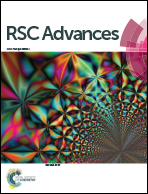First-principles investigation of the surface properties of fergusonite-type monoclinic BiVO4 photocatalyst
Abstract
Fergusonite-type monoclinic BiVO4 (fm-BiVO4) is an important semiconductor photocatalyst as an alternative to TiO2 for solar energy conversion and environmental protection. Based upon density functional theory (DFT) calculations, we report the results of a comprehensive study of the surface properties of fm-BiVO4, including surface geometric/electronic structures, surface energy, work function, Bader charge, and oxygen-vacancy formation energy on the (100), (010), (001), (101), (011), (110) and (111) surfaces. The low-index surfaces of fm-BiVO4 are characterized by surface geometric structures terminated with Bi atoms and VO4 groups. There are strongly localized band-gap states at the (110) and (111) surfaces. The calculated surface energies of fm-BiVO4 indicate a surface stability order of {001} > {011} ∼ {101} > {111} > {110} > {010} ∼ {100}. The equilibrium morphology of fm-BiVO4 is predicted as a corner-cut truncated bipyramid with {001}, {101}, {011} and {111} facets exposed, in good agreement with experiments. The dramatic difference in work function may act as the driving force for photogenerated charge separation between {101}/{011} and {001} as observed in experiments. Based on our results, we provide a clue to morphology design for further enhancing the efficiency of charge separation in fm-BiVO4.



 Please wait while we load your content...
Please wait while we load your content...